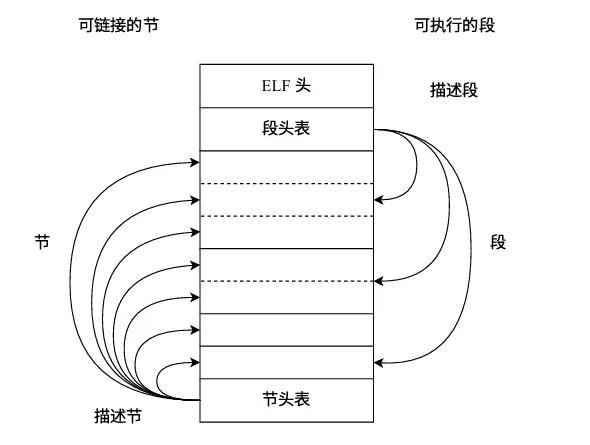一、思考题
Thinking 1.1
在阅读附录中的编译链接详解以及本章内容后,尝试分别使用实验环境中的原生x86工具链(gcc、ld、readelf、objdump等)和MIPS交叉编译工具链(带有mips-linux-gnu-前缀,如mips-linux-gnu-gcc、mips-linux-gnu-ld),重复其中的编译和解析过程,观察相应的结果,并解释其中向objdump传入的参数的含义。
git@23373270:~/test $ gcc -E hello.c > gcc-E.out
# gcc-E.out:
...(<stdio.h>的内容)
# 2 "hello.c" 2
# 3 "hello.c"
int main() {
printf("Hello World!\n");
return 0;
}
git@23373270:~/test $ mips-linux-gnu-gcc -E hello.c > mips-gcc-E.out
# mips-gcc-E.out:
...(<stdio.h>的内容)
# 2 "hello.c" 2
# 3 "hello.c"
int main() {
printf("Hello World!\n");
return 0;
}
进行预处理的情况下,两者几乎没有区别。
git@23373270:~/test $ gcc -c hello.c
git@23373270:~/test $ objdump -DS hello.o > objdump-DS.out
# objdump-DS.out:
hello.o: 文件格式 elf64-x86-64
Disassembly of section .text:
0000000000000000 <main>:
0: f3 0f 1e fa endbr64
4: 55 push %rbp
5: 48 89 e5 mov %rsp,%rbp
8: 48 8d 05 00 00 00 00 lea 0x0(%rip),%rax # f <main+0xf>
f: 48 89 c7 mov %rax,%rdi
12: e8 00 00 00 00 call 17 <main+0x17>
17: b8 00 00 00 00 mov $0x0,%eax
1c: 5d pop %rbp
1d: c3 ret
Disassembly of section .rodata:
0000000000000000 <.rodata>:
...
Disassembly of section .comment:
0000000000000000 <.comment>:
...
Disassembly of section .note.gnu.property:
0000000000000000 <.note.gnu.property>:
...
Disassembly of section .eh_frame:
0000000000000000 <.eh_frame>:
...
git@23373270:~/test $ mips-linux-gnu-gcc -c hello.c
git@23373270:~/test $ mips-linux-gnu-objdump -DS hello.o > mips-objdump-DS.out
# mips-objdump-DS.out:
hello.o: 文件格式 elf32-tradbigmips
Disassembly of section .text:
00000000 <main>:
0: 27bdffe0 addiu sp,sp,-32
4: afbf001c sw ra,28(sp)
8: afbe0018 sw s8,24(sp)
c: 03a0f025 move s8,sp
10: 3c1c0000 lui gp,0x0
14: 279c0000 addiu gp,gp,0
18: afbc0010 sw gp,16(sp)
1c: 3c020000 lui v0,0x0
20: 24440000 addiu a0,v0,0
24: 8f820000 lw v0,0(gp)
28: 0040c825 move t9,v0
2c: 0320f809 jalr t9
30: 00000000 nop
34: 8fdc0010 lw gp,16(s8)
38: 00001025 move v0,zero
3c: 03c0e825 move sp,s8
40: 8fbf001c lw ra,28(sp)
44: 8fbe0018 lw s8,24(sp)
48: 27bd0020 addiu sp,sp,32
4c: 03e00008 jr ra
50: 00000000 nop
...
Disassembly of section .reginfo:
00000000 <.reginfo>:
...
Disassembly of section .MIPS.abiflags:
00000000 <.MIPS.abiflags>:
...
Disassembly of section .pdr:
00000000 <.pdr>:
...
Disassembly of section .rodata:
00000000 <.rodata>:
...
Disassembly of section .comment:
00000000 <.comment>:
...
Disassembly of section .gnu.attributes:
00000000 <.gnu.attributes>:
...
只编译不链接,生成目标文件,发现被编译为不同的汇编语言,且分别为64位和32位。
其中向objdump传入参数-D和-S。
git@23373270:~/test $ objdump --help
-D, --disassemble-all Display assembler contents of all sections
-S, --source Intermix source code with disassembly
-D:显示所有段的汇编内容
-S:将源代码与反汇编代码混合显示
Thinking 1.2
思考下述问题:
- 尝试使用我们编写的readelf程序,解析之前在target目录下生成的内核ELF文件。
- 也许你会发现我们编写的readelf程序是不能解析readelf文件本身的,而我们刚才介绍的系统工具readelf则可以解析,这是为什么呢?(提示:尝试使用readelf -h,并阅读tools/readelf目录下的Makefile,观察readelf与hello的不同)
git@23373270:~/23373270 (lab1)$ tools/readelf/readelf target/mos
0:0x0
1:0x80020000
2:0x80021930
3:0x80021948
4:0x80021960
5:0x0
6:0x0
7:0x0
8:0x0
9:0x0
10:0x0
11:0x0
12:0x0
13:0x0
14:0x0
15:0x0
16:0x0
17:0x0
18:0x0
git@23373270:~/23373270/tools/readelf (lab1)$ readelf -h readelf
ELF 头:
Magic: 7f 45 4c 46 02 01 01 00 00 00 00 00 00 00 00 00
类别: ELF64
数据: 2 补码,小端序 (little endian)
Version: 1 (current)
OS/ABI: UNIX - System V
ABI 版本: 0
类型: DYN (Position-Independent Executable file)
系统架构: Advanced Micro Devices X86-64
版本: 0x1
入口点地址: 0x1180
程序头起点: 64 (bytes into file)
Start of section headers: 14488 (bytes into file)
标志: 0x0
Size of this header: 64 (bytes)
Size of program headers: 56 (bytes)
Number of program headers: 13
Size of section headers: 64 (bytes)
Number of section headers: 31
Section header string table index: 30
观察tools/readelf/Makefile:
readelf: main.o readelf.o
$(CC) $^ -o $@
hello: hello.c
$(CC) $^ -o $@ -m32 -static -g
区别在于hello为32位程序,readelf是64位程序,且hello的编译有-static修饰,是静态链接的。
Thinking 1.3
在理论课上我们了解到,MIPS体系结构上电时,启动入口地址为0xBFC00000(其实启动入口地址是根据具体型号而定的,由硬件逻辑确定,也有可能不是这个地址,但一定是一个确定的地址),但实验操作系统的内核入口并没有放在上电启动地址,而是按照内存布局图放置。思考为什么这样放置内核还能保证内核入口被正确跳转到? (提示:思考实验中启动过程的两阶段分别由谁执行。)
系统能够正确跳转到内核入口在于两阶段启动过程和链接脚本控制:
启动阶段划分
- 阶段一:硬件上电后执行固化在 ROM 中的代码(地址 0xBFC00000)
- 阶段二:Bootloader 加载操作系统内核到指定内存地址
链接脚本控制(kernel.lds)
/*
* Set the ENTRY point of the program to _start.
*/
ENTRY(_start)
SECTIONS {
. = 0x80020000;
.text : { *(.text) }
...
}
- 入口地址设置(start.S)
#include <asm/asm.h>
#include <mmu.h>
.text
EXPORT(_start)
.set at
.set reorder
/* Lab 1 Key Code "enter-kernel" */
/* clear .bss segment */
la v0, bss_start
la v1, bss_end
...
j mips_init
实现原理:
- Bootloader 将内核镜像加载到链接脚本指定的内存地址(0x80020000)
- 通过
ENTRY(_start)指定内核入口符号 - 汇编代码中
_start符号通过绝对跳转指令(j mips_init)转移到内核主函数
二、难点分析与实验体会
1. ELF文件
对ELF文件的概念缺少理解,写完readelf实际使用后才理解其含义。
三、原创说明
本以为是readelf在运行时无法读取自己,是因为自己正在运行导致的无法读取。在与赵德祥同学讨论后才注意到readelf与hello在64位和32位上的区别,在此致谢。
